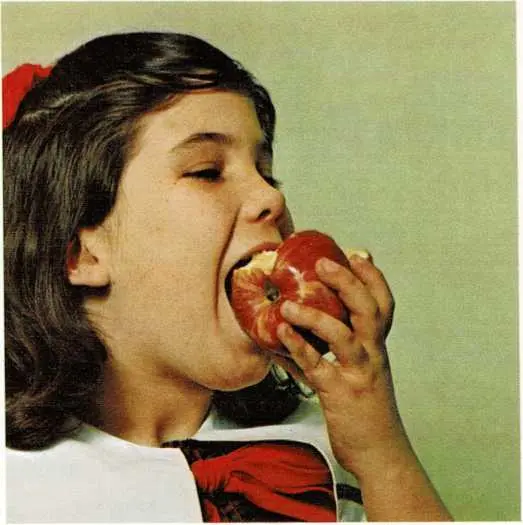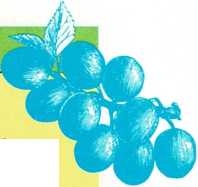Nutrition
Nutrition. The nutrients in food can be divided into certain
groups—proteins, carbohydrates, fats, vitamins, and minerals. Water is
sometimes considered a nutrient.
Proteins are necessary for the gi\’owth and repair of cells.
Proteins help build blood and form antibodies to fight infection. They
also supply energy. The proteins in food are broken down into amino
acids by the body’s digestive system. Then the body cells use the amino
acids like building blocks to put together new and different proteins.
For infants, there are 9 essential amino acids. The body can make others
if it gets these 9, but it cannot manufacture these 9. Some foods
contain all 9 amino acids. These foods, called complete proteins,
include meats, poultry, fish, milk, cheese, and eggs. Other foods
contain some of the essential 9 amino acids. These foods, called
incomplete proteins, include cereals, dried beans, dried peas, and nuts.
Carbohydrates. Starches and sugars, two carbohydrates, supply quick
energy. Starches are found in cereals, bread and other baked goods,
rice, noodles, macaroni, spaghetti, potatoes, lima beans, and corn.
Sources of sugars include candy, fruit, honey, jams, jellies, syrup, and
milk.

Other important carbohydrates are celluloses. Celluloses cannot be
digested, but they supply roughage. Roughage stimulates muscle
contractions in the intestine walls. This helps the body eliminate
wastes. The leaves of vegetables and the skin and pulp of fruits are
good sources of roughage.
If a child does not eat enough digestible carbohydrates, the body burns
protein for
energy. A child needs carbohydrates so that the proteins are spared for
body-building. Nutritionists recommend meeting the carbohydrate needs of
a child mainly through bread, cereals, fruits, green vegetables, milk,
and potatoes. If a child takes too much of the carbohydrate requirement
in the form of sweets, the child’s supply of vitamins, minerals, and
proteins from vegetables and fruits may be lowered. Also, a diet high in
refined sugar, such as candy, can cause tooth decay.
Excess carbohydrates are converted into fat and stored in the body as
fatty tissues. If a child eats more starches and sweets than are needed
for daily energy requirements, the child may become overweight.
Fats are highly concentrated sources of energy. They supply more
than twice the energy of an equal amount of carbohydrates or proteins.
However, fats are digested slower and cannot be used for quick energy.
Fats also supply vitamins A and D. Foods containing fats include cream,
butter, margarine, cheese, egg yolk, fat in meats, salad oils, peanut
butter, nuts, and chocolate.
Basic food groups
The basic seven
Group 1 Meats,
poultry,
fish, eggs,
dried beans
and peas, and
nuts
Group 2 Leafy, green,
and yellow
vegetables
Group 3 Citrus
fruits, raw
cabbage,
salad greens,
and tomatoes
Group 4 Potatoes and
other
vegetables,
and noncitrus
fruits
Group 5 Breads,
cereals, and
flour
Group 6 Butter and
fortified
margarine
Group 7 Milk and milk
products
The basic
four
Meat Group Meats, fish, poultry, eggs, dried
beans and peas, nuts
Vegetable- Vegetables and fruits that provide
Fruit Group vitamin C; dark green, leafy
vegetables and deep yellow
vegetables and fruits; other fruits
and vegetables
Bread-Cereals Bread, muffins, macaroni,
Group spaghetti, rice
Milk Group Fresh whole milk, skim milk, dried
milk, evaporated milk, cheese, ice
cream

Nutritionists recommend that a child have at least 2 glasses of milk
each day. A teen-ager needs 3 or more glasses. Milk products may also
fulfill this need. With the Basic Seven system, nutritionists suggest
one daily serving from each of the remaining six groups. With the Basic
Four system, they recommend four or more servings from both the
vegetable-fruit and bread-cereal groups, and two or more servings from
the meat group.
Fat that is not burned up is stored as body fat. Body fat supports and
protects vital organs and areas such as the eyeballs, the kidneys, the
liver, and the joints. A layer of fat under the skin protects the body
from losing an excessive amount of heat. If a child eats too many fats,
excess body fat is formed and the child becomes overweight.
Fats can be divided into two types—saturated and unsaturated.
Saturated fats are usually solid at room temperature, and unsaturated
fats are usually liquid at room temperature. Most doctors recommend
reducing the amount of saturated fats in the diet and replacing them
with unsaturated fats, because saturated fats are known to raise the
level of cholesterol, a fatty chemical found in the bloodstream. A high
level of cholesterol in the blood may lead to heart disease.
Foods high in saturated fats include chocolate, fatty beef, fatty dairy
products, luncheon meats, and pork. Most margarines, poultry, and veal
are lower in saturated fats. Foods high in unsaturated fats include corn
oil, fish, mayonnaise, and special margarines. Fried foods are full of
the kind of fat they are cooked in.
Minerals. Several minerals are also required by the body. These
minerals include calcium, iron, and iodine.
Calcium helps build bones and teeth, helps blood clot, helps muscles and
nerves work, and helps the body regulate the use of other minerals.
Milk, cheese, ice cream, shellfish, canned sardines, egg yolk, soy
beans, and green vegetables supply calcium.
Iron combines with protein to make hemoglobin, the red substance in
blood that carries oxygen to cells. Good sources of iron include lean
meats, egg yolk, dried beans and peas, green leafy vegetables, prunes,
raisins, dried apricots, liver, heart, kidney, liver sausage, shellfish,
and enriched or whole grain bread, cereal, and cereal products.
Iodine helps control the rate at which the body uses energy. Seafoods
and iodized salt supply iodine.
Vitamins are essential for the utilization of foods for normal
growth and for prevention of certain diseases. Some vitamins, such as
vitamins A and D, may be stored in the
body. Other vitamins must be supplied constantly because the excess is
eliminated.
Vitamins can be divided into two general classes. Vitamins A and D and
others are called fat-soluble because they dissolve in fat. Vitamin C,
B-complex vitamins, and others are called water-soluble because they
dissolve in water. For more information on vitamins, see
[Vitamins.]
Water helps carry nutrients to cells and waste products away from
cells. It also helps build tissues and regulate body temperature. Water
is obtained from liquids and from foods with a high percentage of water.
Nutrients and diet. A well-balanced diet usually provides all the
essential nutrients in sufficient quantity. If your child does not eat
exactly the recommended amounts every day, do not be concerned. Through
regular physical examinations, a doctor can determine if your child is
well nourished.
Conserving nutrients. Store and prepare foods in ways that preserve
nutrients: ■ Keep meat, fish, and poultry in a refrigerator or freezer,
wrapped in plastic wrap or foil.
Keep frozen food frozen until it is used, and cook it as soon as it
is defrosted. Frozen food loses vitamins after thawing and re-
freezing. Never refreeze frozen foods.Wash leafy vegetables and store them in plastic in a refrigerator.
Cook vegetables for the shortest possible time in as little liquid
as possible, [m.g.]
